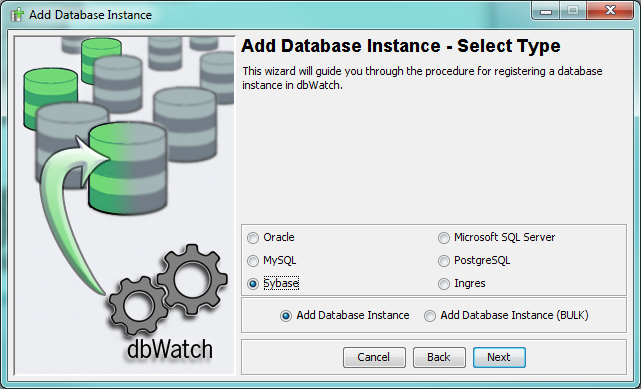How to get here
To add a Sybase instance, click on the “Add” icon on the main toolbar.
This will bring up the “Add Database Instance” wizard, which will guide you through the following steps.
Select Installation Type
The first step of the wizard lets you select the type of installation.
Select Sybase as the database type.
There are two types of installations available, “Add Database Instance” adds a single instance and “Add Database Instance (BULK)” lets you add several instances at once.
Adding instances using BULK uses more default settings and thus allows for less customization. Select “Add Database Instance”.
Click “Next”.
Select Name and Group
Next specify Given Name for the instance. This can be anything you like, but it must be a unique name since it will be used to identify this instance in dbWatch.
Given Name cannot contain the following characters: ‘/’, ‘?’, ‘’‘, ‘\’, ‘{‘, ‘}’, ‘<’, ‘>’, ‘;’, ‘&’, ‘%’, ‘#’, ‘\’, ‘,’.
Group specifies the group this instance will sort under, the default groups are Development, Test and Production.
There are two modules available for installation, Administration and Monitoring.
Click “Next”.
Select Connection Details
Next you specify the connection details for the instance.
This step will look slightly different depending on what modules you selected in the previous step.
Administration and Monitoring
The login/password you specify here will be used during installation of the dbWatch framework and must have the necessary privileges to create the dbWatch login (and database).
If you select “Use as admin login”, this login will be used as the default administration login when you access the administration module for this instance.
Administration only
The login/password you specify here will be used as the default administration login when you access the administration module for this instance.
Monitoring only
The login/password you specify here will be used during installation of the dbWatch framework and must have the necessary privileges to create the dbWatch login (and database).
Click “Next”.
Select Device/Database/Login
This step will only be shown if the Monitoring module is selected.
Here you can specify if the dbWatch database should be placed in a custom device, or in an already existing one.
To view and change device details, click “Details”
You can also specify if the log should be placed in a seperate device.
Then specify a name for the dbWatch database and a login and a password for the dbWatch login.
Click “Next”.
Select Tasks
This step will only be shown if the Monitoring module is selected.
Here you can specify the monitoring tasks that should be installed for this instance. As you can see a number of tasks have been pre-selected, these are the “Standard” tasks that dbWatch recommends installing.
Click “Next”.
Installation Summary
Here you can see a summary of the installation details you have provided. If you are satisfied, click “Next”.
Installation
The instance will now be registered in dbWatch. Depending on the modules selected, network and instance, this process can take from a few seconds to a few minutes.
When the installation is completed, you should get the following message.
← Adding a SQL Express Instance / Adding Instances With Existing Schema →














Post your comment on this topic.